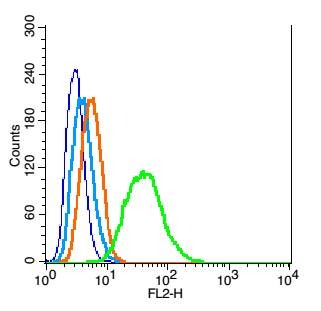Shopping Cart
Remove All Your shopping cart is currently empty
Your shopping cart is currently empty
Anti-CDKN1B Polyclonal Antibody is a Rabbit antibody targeting CDKN1B. Anti-CDKN1B Polyclonal Antibody can be used in FCM,IF,IHC-Fr,WB.
| Pack Size | Price | USA Warehouse | Global Warehouse | Quantity |
|---|---|---|---|---|
| 50 μL | $220 | 7-10 days | 7-10 days | |
| 100 μL | $372 | 7-10 days | 7-10 days | |
| 200 μL | $528 | 7-10 days | 7-10 days |
| Description | Anti-CDKN1B Polyclonal Antibody is a Rabbit antibody targeting CDKN1B. Anti-CDKN1B Polyclonal Antibody can be used in FCM,IF,IHC-Fr,WB. |
| Synonyms | p27Kip1, KIP1, Cyclin-Dependent Kinase Inhibitor p27, Cyclin-Dependent Kinase Inhibitor 1B, CDKN1B |
| Ig Type | IgG |
| Reactivity | Human,Mouse,Rat (predicted:Chicken,Dog,Pig,Sheep) |
| Verified Activity | 1. Blank control: RSC96 (blue), the cells were fixed with 2% paraformaldehyde (10 min) and then permeabilized with ice-cold 90% methanol for 30 min on ice. Isotype Control Antibody: Rabbit Igg (orange); Secondary Antibody: Goat anti-rabbit IgG-Pe (white blue), Dilution: 1:200 in 1 X PBS containing 0.5% BSA; Primary Antibody Dilution: 1 μg in 100 μL 1X PBS containing 0.5% BSA (green). 2. CDKN1B (p27Kip1) was immunoprecipitated from mouse kidney tissue with TMAB-00410 at 1/150 dilution. Western blot was performed from the immunoprecipitate using protein A/G beads. HRP Conjugated Goat anti-Rabbit IgG (Heavy Chain specific) was used as secondary antibody at 1:5000 dilution. Lane 1: mouse kidney tissue lysate 10 µg (Input). Lane 2: TMAB-00410 IP in mouse kidney tissue lysate. Lane 3: native rabbit IgG IP in mouse kidney tissue lysate (negative control). Secondary: Goat anti-Rabbit IgG (Heavy Chain specific), HRP Conjugated, 1:5000 3. Sample: 293t (Human) Cell Lysate at 30 μg U2os (Human) Cell Lysate at 30 μg Primary: Anti-CDKN1B/p27 KIP 1 (TMAB-00410) at 1/1000 dilution Secondary: IRDye800CW Goat Anti-Rabbit IgG at 1/20000 dilution Predicted band size: 22 kDa Observed band size: 22 kDa    |
| Application | |
| Recommended Dose | WB: 1:500-2000; IHC-Fr: 1:100-500; IF: 1:200-800; FCM: 1μg/Test |
| Antibody Type | Polyclonal |
| Host Species | Rabbit |
| Subcellular Localization | Nucleus. Cytoplasm. Endosome. Note=Nuclear and cytoplasmic in quiescent cells. AKT-or RSK-mediated phosphorylation on Thr-198, binds 14-3-3, translocates to the cytoplasm and promotes cell cycle progression. Mitogen-activated UHMK1 phosphorylation on Ser-10 also results in translocation to the cytoplasm and cell cycle progression. Phosphorylation on Ser-10 facilitates nuclear export. Translocates to the nucleus on phosphorylation of Tyr-88 and Tyr-89. Colocalizes at the endosome with SNX6; this leads to lysosomal degradation. |
| Tissue Specificity | Expressed in all tissues tested. Highest levels in skeletal muscle, lowest in liver and kidney. |
| Construction | Polyclonal Antibody |
| Purification | Protein A purified |
| Appearance | Liquid |
| Formulation | 0.01M TBS (pH7.4) with 1% BSA, 0.02% Proclin300 and 50% Glycerol. |
| Concentration | 1 mg/mL |
| Research Background | Cell cycle progression is regulated by cyclins and their cognate Cdks. p27 KIP 1 is a cell cycle regulatory mitotic inhibitor of cdk activity. p27 KIP 1 is a candidate tumor suppressor gene, and has been proposed to function as a possible mediator of TGF beta induced G1 arrest. p27 KIP 1 is up regulated in response to antimitogenic stimuli. The increased protein expression of p27 results in cellular arrest by binding to cyclin/Cdk complexes such as cyclin D1/Cdk4. p27 Kip1 is regulated by phosphorylation on serine 10 (S10) and threonine 187 (T187). Phosphorylation by CDK2 on T187 results in ubiquitylation and degradation of p27 Kip 1; while phosphorylation by hKIS on S10 signals the nuclear export to the cytoplasm. |
| Immunogen | KLH conjugated synthetic peptide: human P27 kip1 |
| Antigen Species | Human |
| Gene Name | CDKN1B |
| Gene ID | |
| Protein Name | Cyclin-dependent kinase inhibitor 1B |
| Uniprot ID | |
| Biology Area | Cip/Kip,Cip / Kip,Cip/kip |
| Function | Important regulator of cell cycle progression. Involved in G1 arrest. Potent inhibitor of cyclin E- and cyclin A-CDK2 complexes. Forms a complex with cyclin type D-CDK4 complexes and is involved in the assembly, stability, and modulation of CCND1-CDK4 complex activation. Acts either as an inhibitor or an activator of cyclin type D-CDK4 complexes depending on its phosphorylation state and/or stoichometry. |
| Molecular Weight | Theoretical: 22 kDa. |
| Stability & Storage | Store at -20°C or -80°C for 12 months. Avoid repeated freeze-thaw cycles. |
| Transport | Shipping with blue ice. |
| Size | Quantity | Unit Price | Amount | Operation |
|---|

Copyright © 2015-2026 TargetMol Chemicals Inc. All Rights Reserved.